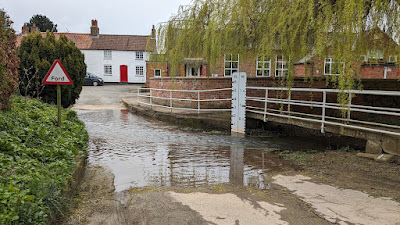Although the sky is overcast and the weather forecast threatens light showers, I get the 8:31 bus to Scorborough. It’s strange to think that Scorborough had its own beach in the last Interglacial. Now, the little village with a long history sits by a lovely beck and has an impressive church and parkland. I take a walk around the village before starting the stage proper. Scorborough Beck passes under the Driffield Road via a three arch brick bridge. There seem to be many water vole burrows, but they could be old, I see no other signs of activity. The Rooks are in full swing from their nests on large Oaks on Scorborough Park. A Great Spotted Woodpecker drums.
Time to start walking the route. The first stage involves crossing a couple of arable fields. I check with my binoculars to aim for the yellow arrow of the public right of way, as the paths are not well trodden and there are no footprints across the crop. Skylarks sing and a pair of Red-legged Partridges run away in the distance.
The route follows the Minster Way until Cawkeld Sinks. The following fields are very low-lying, with rushy springs, and very wet. Some impressive willows lay spread on the field boundary. I get distracted and end up on the wrong side of Bryan Mills Beck. It’s quite shallow and narrow and I briefly consider taking my shoes off and just crossing it, but I end up turning round and crossing the plank bridge. Ahead, by the beck, a nervous Grey Wagtail watches me.
At Lockington, I walk by St Mary’s church, flanked with some large yews, and follow through the village, cross a bridge over Brian Mills and as I walk along Front street, I’m delighted with its several fords (at least three!). I leave the village, and the valley of Brian Mills Beck on a quiet lane, Pit Lane with a noticeably uphill.
The route is now almost due north, by arable fields and plantations. Three Buzzards soar over Southbelt Plantation, Skylarks chase on the fields, a Yellowhammer sings from the hedge. I soon get to Kilnwick, and its beck, Kilnwick beck, which is upstream of Watton Beck valley.
I leave the Minster Way now, aiming for Hutton Cranswick. It starts to drizzle, and I’m around an hour away from Hutton Cranswick so I press on, walking by Burn Butts Farm and the evocatively named Bustard’s Nest Farm and Little Bustard Farm. As I get to Hutton Cranswick, I watch a pair of Lapwing on a field.
I get my lunch at Cranswick Farm shop. Afterwards, as I make time for the 15:04 bus, I walk to the Cranswick village pond, which will be the start of the next walk.
Plenty of fresh molehills, rabbits from the bus and roe deer prints make the mammal count of the day.
Brown Bears, Ursus arctos, the same species that inhabited England during the Ipswichian. Unfortunately there are few securely dated fossils. These include some from Barrington, Cambridge, and Cefn Caves in North Wales. A young bear jaw was reportedly found at Sewerby buried cliff, but the specimen is now lost, and that is the only East Yorkshire fossil from the Ipswichian I’ve been able to find references to. The Brown Bear needs little description, it is a large omnivore, and in the last interglacial it would have roamed across all lowland habitats, not just restricted to mountains as it is now. The Brown Bear has the broadest diet of any bear, and tends to exploit abundant, easy to find prey in an opportunistic way. It would have moved onto rivers to catch salmon during migration, it would have been at ease in woodland, to feed on acorns, beech mast and root around the woodland floor for grubs or nests, or wandered along the coast to take advantage of clams, crabs or carrion on the shoreline. Young deer or other mammals could have been predated opportunistically.
Brown Bears survived in glacial times and recolonised England very quickly after the last glacial maximum suggesting that they might have persisted in southern England. It is unlikely that they made it in a wild state beyond Roman times in the UK, although captive individuals were imported for bear-baiting until medieval times. In mainland Europe, Brown Bears populations managed to persist in mountainous areas of South and Eastern Europe and Scandinavia and since the 60s, populations have increased due to better protection and reintroductions. There is no evidence that Cave Bears, a different species, lived in the UK during the Ipswichian, but today's Brown bears have a little Cave Bear ancestry in their genomes.
More information
Barnett, R. 2019. The Missing Lynx: The Past and Future of Britain’s Lost Mammals. Bloomsbury Publishing, 2019.




























No comments:
Post a Comment